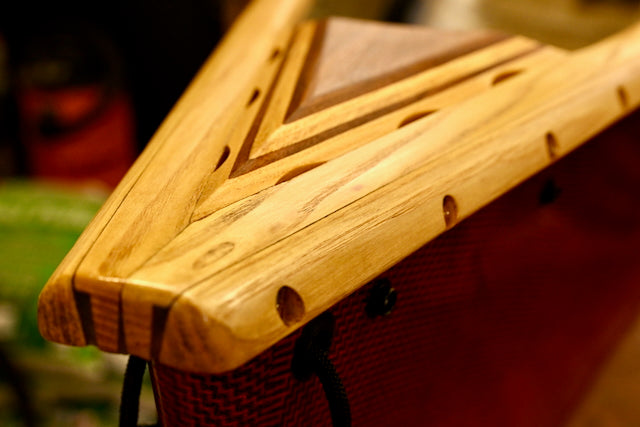

Wood gunwales are more than just beautiful trim on your canoe – they're crucial structural components that protect your hull and provide essential rigidity. All of that gorgeous wood is constantly exposed to sun, water, and weather and needs regular maintenance to prevent damage and maximize its life. In this guide, I'll walk you through the complete process of maintaining your canoe's wood gunwales, from inspection to finishing.
Table of contents
What You'll Need
Before starting, gather these materials:
100 and 220-grit sandpaper with a firm foam sanding block
Tack cloth or clean rags for cleaning
WATCO Exterior Wood Finish
Low odor mineral spirits
2-inch green or blue painters’ tape
Natural bristle brush
Protective gear: gloves, eye protection, and a respirator or dust mask
Heavy paper towels or clean rags
Shop Vac (if working indoors)

We prefer WATCO Exterior Wood Finish in Natural tint, but it can be hard to find. We order ours from Rutabaga Paddlesports or Northstar Canoes.
WATCO Teak Oil is another great option with similar performance and longevity, plus it's easy to find at most local hardware store
Inspection: What to Look For
Start with a thorough inspection of your gunwales. Run your hand along the entire length, feeling for rough spots, splinters, or soft areas. Pay special attention to the underside and ends of the gunwales and bow and stern decks. These areas can collect water when stored upside down and are prone to rot and water damage.
Look for:
Dark spots indicating water damage
Splits in the wood
Heavy mildew
Loose fasteners
Grey wood
Even if you don't find major issues requiring repairs, your gunwales might still need maintenance. For example, my Northstar Phoenix gunwales are in great shape after a full season of service and outdoor storage under a WeatherMax 3D Original Canoe Cover, but they still need routine annual maintenance to protect them during the next paddling season.
How could I tell?
Reduced water resistance: Water no longer beads up when they get wet.
Appearance: They look slightly dull and dry and had very light mildew where the gunwales rest against the rack arms where the canoe is stored, outdoors.
Time: It has been a year since they were given a full oiling.

Preparation: Set Up for Success
Choose a well-ventilated work area with temperatures between 50 and 90 degrees Fahrenheit and low humidity. Position your canoe at a comfortable working height using padded sawhorses, proper canoe stand, or your backyard picnic table.
For annual maintenance, I like to remove the thwarts, yoke, seats, and seat hangers. This allows complete access to all parts of the gunwales and provides an opportunity to maintain these components as well. Keep track of exactly what hardware comes from which part of the boat so that everything goes back together smoothly.
Protect your hull by applying masking tape to both the interior and exterior surfaces below the gunwales. This double protection prevents scratches from sandpaper or finish drips from marring either side of your hull.
The Refinishing Process
Step 1: Sanding
Start with 100-grit sandpaper on your foam sanding block, working in the direction of the wood grain with steady, even pressure. This step removes mildew, dirt, scuffs, and splinters while opening the wood's pores for better oil penetration. If you find deeply weathered, grey or soft wood during this process, your gunwales might need more extensive repairs than routine maintenance.
After the initial sanding, clean thoroughly with a tack cloth, then progress to 220-grit for a final light sanding. This creates an ideal surface for the oil finish while maintaining open pores for good penetration. Sanding with a higher, finer grit can polish the surface of the wood and close the pores, reducing penetration of the oil.
Vacuum and wipe with a tack rag again, then give everything a final wipe with mineral spirits to ensure perfect cleaning and enhance oil penetration.
Finally, protect yourself and don't skip the safety gear – wear your dust mask when sanding and gloves when applying finish.
Step 2: Applying the Finish
Using a natural bristle brush, apply WATCO Exterior Finish generously, working in two-foot sections. The wood gunwales will absorb the finish differently in various areas – some spots might need multiple applications while others remain wet. If you see dry areas or spots where the oil has been completely absorbed, apply more. You want the wood surface flooded with oil; don’t be stingy.
After applying the first coat of finish, walk around the boat with a rag and mineral spirits, removing any drips or runs on the interior or exterior of the hull. If drips or runs dry on the canoe surface, they can be difficult to remove.
After 30 minutes, apply a second coat, again flooding the surface and paying special attention to any areas that absorb quickly. Let this second coat penetrate for 15 minutes, then wipe any remaining oil from the surface with a clean rag.
Remove the masking tape and, once again, walk around the boat and wipe up any drips or runs from the inside and outside of the hull.
Step 3: Curing
Allow 8-10 hours of drying time before exposing the gunwales to moisture or temperatures below 50 degrees. If you’re refinishing your boat outdoors, beware of night time temperature drops, dew, and condensation during the cure. You may need to move the canoe into a garage or shed, or time your cure so that it’s finished before the sun goes down.
The Watco Exterior Oil will leave your wood gunwales feeling and looking natural while hardening inside the wood's pores and grain to protect against water absorption and mildew. .
Wood Gunwale Maintenance Schedule and Tips
Plan on refinishing your wood gunwales annually, typically in spring before the paddling season begins. For mid or late-season touch-ups, a light sanding with 220-grit paper and a single coat of oil can carry you through until the next annual treatment.
Pro Tips for Long-Lasting Results
Always use penetrating oil on your wood gunwales, not marine varnish or urethane. Film finishes can chip, peel, and crack, trapping water underneath and causing mildew and rot. Penetrating oils provide better protection and easier touch up maintenance.
Avoid overnight finishing outdoors. Dew and condensation can interfere with curing. The finish must stay dry and above 50 degrees during the entire curing process.
Skip the "natural" oils. While it's tempting to use 100% natural linseed, tung, or hemp oil, these can take weeks (or even months) to polymerize and often create mildew due to their organic compounds. Watco's Exterior Finish and Teak Oil, with their blends of natural oils, synthetic oils, driers, and solvents, penetrate deeper, cure faster, and resist mildew better.
Stay on schedule. An hour of maintenance in Spring (and, perhaps, a touch-up in late Summer) can be the difference between wood gunwales that last a lifetime and wood gunwales that need complete replacement after 5 or 6 years.

The Bottom Line
Proper wood gunwale maintenance isn't just about aesthetics – it's about protecting your investment and ensuring your canoe stays seaworthy for years to come. Take your time with the prep work, use the right materials, and stay ahead of weathering and rot. Your canoe and its wood gunwales will reward you with many years of reliable service!


